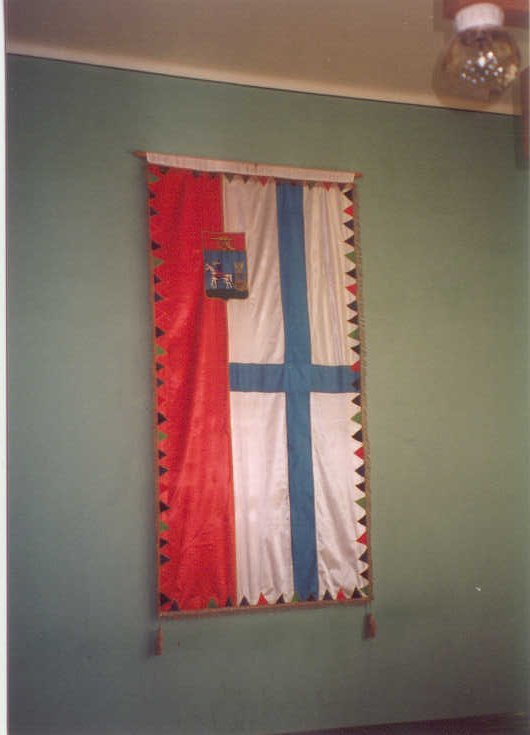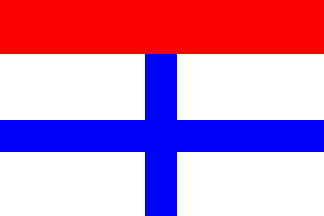![[flag of Kézdivásárhely, Harghita County]](../images/r/ro-cv-ts.gif) by
István Molnár, 17 March 2001
by
István Molnár, 17 March 2001

Last modified: 2015-07-28 by alex danes
Keywords: targu | secuiesc | szekely | kezdivasarhely | romania | covasna | kovaszna |
Links: FOTW homepage |
search |
disclaimer and copyright |
write us |
mirrors
![[flag of Kézdivásárhely, Harghita County]](../images/r/ro-cv-ts.gif) by
István Molnár, 17 March 2001
by
István Molnár, 17 March 2001
See also:
Other sitesTârgu Secuiesc (in Hungarian Kézdivásárhely ) is a town in Covasna (Kovászna) County of Romania (Transylvania). The commune contains two settlements: Town of Târgu Secuiesc / Kézdivásárhely and Lunga / Nyujtód village. The town has got 22.912 inhabitants (20.998 (91,6%) Hungarians, 1992 census). The settlement is one of the historical and traditional centres of the Székely Land (Terra Siculorum). The name of Kézdivásárhely has two parts: Kézdi, means 'from Kézd' - the town is located in the former Kézdi district of the Székely Land settled by the Székelys from Kézd (in Rumanian: Saschiz) and its envirouns in the 12th century. Vásárhely means 'Market Place'. neighbouring communities are: Sânzeni / Kézdiszentlélek, Turia / Torja, Catalina / Szentkatolna, Ghelinţa / Gelence, Ojdula / Ozsdola, Breţcu / Bereck, Lemnia / Lemhény and Poian / Kézdiszentkereszt communities.
In the territory of the settlement there was a Roman settlement of Dacia Province (Praetoria Augusta). The first mention of the settlement is from 1407 as 'Torjawasara'. City from 1427 by King Sigismund of Luxemburg. After the Battle of Mohács (1526) which ended the independent Kingdom of Hungary, Kézdivásárhely became a part of the Principality of Transylvania (1552-1765) later Grand Duchy of Transylvania (1765-1867). The first mention as 'Kyzdy Wasarhel' is from 1562. The settlement was an important place of the Revolution and Independence War (1848-1849) 1867-1918/1920 part of the Kingdom of Hungary. In 1910 the settlement was a town in the Háromszék (in Rumanian Treiscăune) County of the Kingdom of Hungary. Inhabitants in 1910: 6.079; 5.970 (98,2%) Hungarian, 50 (0,8%) Rumanian and 59 (1,0%) other by mother tongue, 3.153 (51,9%) Roman Catholic, 2.617 (43,0%) Calvinist, 95 (1,6%) Jew, 71 (1,2%) Greek Catholic, 65 (1,1%) Greek Orthodox and 78 (1,3%) other by religion. In 1916, from 2nd September to 10th October the town was under Rumanian occupation. From 1918/1920 (Romanian occupation / Treaty of Trianon) to 1940 (Second Decision in Vienna) part of the Kingdom of Romania. 1940-1944 part of Hungary. The Treaty of Paris reallocated it to Romania. The settlement was a town 1952-1960 in the Hungarian Autonomous Region, 1960-1968 in Braşov Region and from 1968 is in Covasna County.
István Molnár, 2 Dec 2000
located at http://www.gyongyos.hu/varos/testverek/index.html
as same as in 1909.
István Molnár, 10 Dec 2000
 by István Molnár
by István Molnár
[Click on flag for larger image]
The ceremonial flag consists of the flag
in a vertical format, and the coat of arms overlapping the red-white boundary in
the "hoist" area.
István Molnár, 2 January 2002
 by António Martins, 28 February 2001
by António Martins, 28 February 2001
Horizontal unequal diband: the upper part (wide 1/4th of the hoist) red; the bottom part white with a blue cross throughout (width = 1/6th of the hoist).
António Martins, 28 February 2001
This flag appears at Dr. Széll Sándor: Városaink neve, címere és
lobogója (1941) as "Kézdivásárhely, Háromszék Co.".
István Molnár, 2 Dec 2000